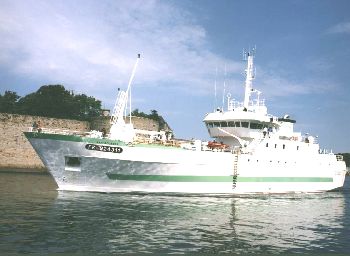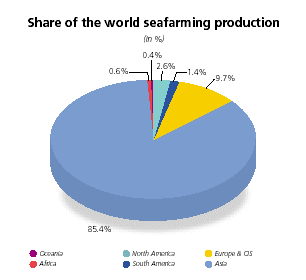
|
The fishing
vessel market in 2001
|
|
|
|
|
| |
|
|
|
Tuna
fish : what future ?
|
|
|
France and her overseas territories have
accumulated an impressive "savoir faire" and a fishing fleet of
35 refrigerated tuna seiners, which places it as number seven after Spain,
Taiwan, the U.S., Mexico and in the same group as Venezuela and Equator
and tied with Japan.
The technological developments have allowed the fleet to be totally
adapted to the needs of fishing, namely to track down by satellite (using
thermal detection) favourable areas where banks of tuna are concentrated,
but also Argos beacons, undetectable by competitors' ship radar, which
give the position of artificial wrecks supposedly swarming with tuna and
which float over thousand of nautical miles.
The main species of tuna are the bluefin (or red tuna), the albacora
(or white tuna), the bigeye (or patudo), the yellowfin (or yellow-jawed
tuna), and the skipjack (or listao).
No mention of this industry and its current status or future
development can be made without reference to canned tuna, in France,
Europe and the World, which consumes 60 % of the catch, whereas the other
forms of conservation - fresh, frozen, smoked, dried' make up the
rest.
The world resources of tuna and other fish cannot be indefinitely
exploited without causing a rapid depletion in the stock and serious
disruptions in the market. Fishing techniques, which are not controlled
and restricted, are aggravating the supplies of tuna. The search for
efficiency and higher returns has made spectacular progress from the
so-called "californian" method to the "turning seine"?
But other reasons have pushed certain fleets to go only after shoals of
tuna on the surface, easy to encircle, by using extremely cheap manpower
on seiners with ever-increasing capacity (up to 1,500 tons). This is the
development of fishing on artificial wrecks or FADs (Fish Aggregating
Devices), which are tracked at great distance by satellite and
occasionally are accompanied by exploration ships, the "auxiliary
vessels".
Europeans have been able to track tuna on the move for a long time by
using the "school" fishing technique and catch a higher
percentage of yellowfins (neothunnus albacares), some 35 to 50 %, compared
to Asians, who concentrate much more on the listao (katsuwonnus pelamis)
which represent some 90 % of their take. Another serious problem posed by
fishing off artificial wrecks, is that no selection is made between tuna,
good for conservation and the young or small, which have little commercial
interest and get destroyed, as is the case for the patudo (thunnus
obesus), nowadays a particularly threatened specie.
Despite attempts to limit the catches on wrecks in the Atlantic and the
Eastern Tropical Pacific, during the course of 2000 and this year, catches
have again far exceeded what would be a reasonable amount for the normal
market needs for conservation. In practice, the world fleet of big seiners
remains around 400 units, but the average size of these ships has a
tendency to grow on account of the increase in the
"jumboisation" of hulls to expand their capacity to take on
tuna, but also the introduction of new units of 110 metres long and with a
3,000 ton capacity. However the average age of the world tuna industrial
fishing fleet is over 20 years, and even though orders of new vessels have
currently stopped, one can reasonably expect to see a start-up again soon.
Record hauls are being recorded using the powerful modern techniques to
supply too-many transformation installations, which are in surplus to a
market that is growing very slowly in Europe and stagnating elsewhere. It
is hardly surprising that the industry hit its worst crisis in 1999-2000,
with the price of tuna at all time lows of 30 years ($ 350/t C&F
Bangkok) and canned stocks oversupplied. A number of players have at last
realised that it is high time to introduce measures aimed at protecting
resources and to establish operating standards, which will allow the
industry to remain permanently in business.
|
 |
Ile Bourbon
long liner, 55.50 m, blt 2001 by Piriou, operated by Armements R'unionnais |
|
| Consumer
market evolution |
|
|
Canned fish is easy to use but is becoming
outdated. Nowadays, with constant changes in feeding habits, the
"fast food" and "prepared meals" are the new fashion
for eating. But while demand for fresh and prepared tuna is spreading,
canned product still counts. Tuna remains in the forefront of canned fish
and is the favoured choice for the production lines of the big
distributors. This trend is based largely on special brand labelling from
the main producers, reinforced with advertising and has, like most
foodstore items, seen a development of "own brands" from the
distributors.
In France the growth of tuna and vegetables in the "salad"
market has stimulated production lines which assembly the tuna cuts,
together with the other ingredients in highly mechanised fashion. Having a
headstart over other European countries, we possess a complete logistic
network for frozen tuna with advanced infrastructure, from the factories
in Africa which supply directly into Europe "outside customs" to
the conception and realisation of classic and innovative products
distributed throughout Europe. Notwithstanding, the three main national
companies have been taken over by multinationals (American, Moroccan, and
recently Italian).
Italy has remained faithful to tuna in olive oil, but they rely more
and more on imported cuts. Preparation is done in the traditional way from
the whole tuna (tonno grezzo) on the spot, however legislation makes no
differentiation between this method and that of canned cuts, either in
Italy or throughout Europe or in the rest of the world. The Spanish, whose
methods of preparation are to the taste of Italians, have seen the chance
that the Italian market offers to develop their canned exports where they
control two important national Italian brand names.
Spain has become a major player in the last decade of the 20th century.
She possesses many advantages with her fishermen, industrialists, a
dynamic entrepreneur spirit, and support from both her Government and from
Europe. Next to tuna, the second in importance is the sardine, but with a
prominent role that the canning of specially prepared sea-food (mariscos)
plays in supporting a large number of small and medium-size companies with
product that Asian suppliers are unable to provide. And while talk of
mergers amongst the canning companies is on everybody's lips, it appears
that our neighbours are very attached to the notion of keeping a family
control in business. Meanwhile the Spanish tuna network is currently
spreading "urbi et orbi" both within and outside Europe.
Finally it is to be noted that the tuna canning market has seen a
remarkable growth in the U.K. In 1998, canned imports were even higher
than that in France. Two big private brands, controlled by powerful
international groups, supply the lion's share of the U.K. market. It is
interesting to see that they do not have the integrated network with
fishing boats' but they have exclusive partnership agreements with
companies operating out of certain ACP countries on the Atlantic and
Indian Ocean seaboards, a recognition of sorts that the French model
developed over the past 30 years was not so bad after all.
|
| Can
aquaculture compete with traditional fishing? |
|
|
Aquaculture, the more or less controlled breeding
of aquatic species, although practised for several millions of years in China,
has only seen an important development in the last 50 years in fresh water and
the last 20 years in salt water. Figures from the FAO estimate the fish
production at 92.3 million tons and 32.9 million tons for aquaculture, a total
of 125.2 million tons (1999 figures).
In comparison to traditional fishing, the aquaculture production only
represents a third of the fishing sector, but as nearly all the available
resources are fully utilised in traditional fishing, an increase in supply can
only come from the aquaculture end.
The seafarming production is very unevenly distributed between the various
continents as the following table shows.
|

|
|
Behind these figures lie a great diversity in
the types of aquaculture practised.
Fresh water fish represent the largest seafarming production in the
world, with 17 million tons produced in 1998, thanks to China and India.
The breeding of herbaceous species has been encouraged for subsistence and
has been integrated into production systems in rural areas. There is
consequently few big commercial activities, apart from the red tilapia,
for which there is a ready-made market.
The carnivorous fresh water species are for the most part bred in an
intensive system fed with artificial food. These species are therefore
expensive to produce, despite the important progress made in the
conversion rates as well as production cost of the food. Fresh water
salmon can be interesting to developing countries with mountainous areas
which have natural cold water (below 18'C).
Compared to fresh water fish, the marine species represent a much
smaller volume of production, with 781,000 tons (1998 figure). The species
bred have a high commercial value and are for the most part carnivorous.
The economic importance of species produced in aquaculture has allowed the
financing of studies on the techniques of breeding done by governmental
bodies and the breeders themselves. Apart from salmon, the species
currently being bred are widespread, as each country has a tendency to
produce the right fish for its own market. Salmon is a breed apart in that
the control of the technical aspects of production has allowed such
savings in costs and amazing results that it has been possible to move
from a luxury item to one of a normal everyday consumption.
In aquaculture the main species are the sea bass, john dory, turbot,
striped bass, the red drum and the tropical sea bass. Species whose habits
are in the process of being fully controlled are the sole, cod, halibut,
and youngs coming from a natural habitat are the grouper, snapper, tuna,
and the sea bream
|
|
In terms of traditional fishing, the main species
caught are: peruvian anchovies (thanks to the end of the "el Nino"
stream), the Alaskan pollock, the Atlantic herring, the skipjack tuna, and the
chub mackerel.
The prospects of developing aquaculture, apart from the purely subsistence
activity, lies essentially in the transfer of breeding techniques of species
whose habits are now fully under control to countries which have very low
production costs. In this way commercial breeding can be envisaged for a
variety of species such as the marine shrimp, the catfish, or the barramunda.
However the feasibility of such projects is highly conditional upon the supply
of good quality food at low prices. In Europe one can foresee a development of
aquaculture systems in closed circuits which provides a good solution to
environmental concerns which are becoming more acute.
These very same ecological concerns are growing in importance and posing
problems to traditional fishing. It is probable that fishing with the
traditional trawl will decline given the damage done to the species being
fished, and that there will be an important increase in longliners which are
selective and have the merit of protecting the young and the reproduction
cycles. There is a groundswell movement to have better controls on quotas,
species fished, and the protection of the environment in order that the
consumer will be able to maintain a choice between the quality of products from
the sea delivered by the traditional fishing and a variety of cheaper products
coming from aquaculture.
|
|
To our good readers, the trends and statistics
have been supplied to us by Soci't' Cofrep'che (Paris). The
developments concerning the future of the tuna industry have been made in
collaboration with our friend Michel Delrue, well known in the
international tuna world.
|
Shipping and Shipbuilding Markets in 2001
I N D E X
|